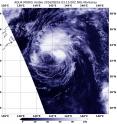NASA sees wind shear affecting Tropical Storm Chanthu
Visible imagery from NASA's Aqua satellite showed wind shear was affecting Tropical Storm Chanthu as it moved parallel to the big island of Japan early on Aug. 16. Chanthu is expected to make landfall and move north over the island of Hokkaido. On Aug. 15 at 11:25 p.m. EDT (Aug. 16 at 0325 UTC) visible imagery from the MODIS or Moderate Resolution Imaging Spectroradiometer instrument aboard NASA's Aqua satellite showed clouds and showers in Chanthu were being pushed to the north and east from moderate southwesterly vertical wind shear.
On Aug. 16 at 11 a.m. EDT (1500 UTC), the center of Tropical Storm Chanthu was located near 36.2 degrees north latitude and 141.1 degrees west longitude. That's about 64 nautical miles east of Yokosuka, Japan. Chanthu is moving toward the north-northwest at 20.7 mph (18 knots/33.3 kph)
Maximum sustained winds were near 40 mph (35 knots/62 kph) and Chanthu is expected to maintain strength over the next day as it moves over the northern part of the big island of Japan.
For updated warnings and watches from the Japan Meteorological Agency, visit: http://www.jma.go.jp/jma/indexe.html.
The Joint Typhoon Warning Center said that Chanthu is expected to track more north-northeastward as a sub-tropical ridge (elongated area of high pressure) weakens in response to an approaching mid-latitude trough (elongated area of low pressure). By early Aug. 17, Chanthu is forecast to being extra-tropical transitioning where it will become a cold-core low pressure area.
Source: NASA/Goddard Space Flight Center
Articles on the same topic
- NASA sees examines new tropical storm in infrared lightThu, 25 Aug 2016, 18:04:09 UTC
- Tropical Depression 14W gets absorbed by system 92WThu, 25 Aug 2016, 16:04:25 UTC
- NASA sees a small tropical depression 14WWed, 24 Aug 2016, 17:06:54 UTC
- GPM sees Tropical Depression Kay fading into historyWed, 24 Aug 2016, 17:06:44 UTC
- NASA sees Lionrock strengthen into a typhoonWed, 24 Aug 2016, 16:36:10 UTC
- NASA's GPM observes Tropical Storm Gaston's developmentWed, 24 Aug 2016, 16:05:31 UTC
- NASA satellite spots new tropical depression in Northwestern Pacific OceanTue, 23 Aug 2016, 19:07:00 UTC
- NASA's Aqua Satellite sees Tropical Depression Kay sevoid of strengthTue, 23 Aug 2016, 17:04:40 UTC
- NASA sees Tropical Storm Lionrock sonsolidatingTue, 23 Aug 2016, 16:04:52 UTC
- NASA witnesses Atlantic's Tropical Storm Gaston coming togetherTue, 23 Aug 2016, 16:04:42 UTC
- NASA Sees a Fading Fiona in AtlanticTue, 23 Aug 2016, 16:04:33 UTC
- NASA-NOAA's Suomi NPP Satellite sees two Tropical Cyclones near JapanMon, 22 Aug 2016, 17:34:20 UTC
- NASA sees Tropical Storm Fiona weakening from wind shearMon, 22 Aug 2016, 15:03:47 UTC
- NASA sees Tropical Storm Lionrock south of JapanFri, 19 Aug 2016, 18:04:13 UTC
- NASA spies Tropical Storm Mindulle's southern side strengthFri, 19 Aug 2016, 18:04:06 UTC
- NASA's Terra Satellite sees Tropical Storm Dianmu over VietnamFri, 19 Aug 2016, 18:03:54 UTC
- NASA spots strong convection in strengthening Tropical Storm KayFri, 19 Aug 2016, 15:05:16 UTC
- NASA sees wind shear affecting Tropical Storm FionaFri, 19 Aug 2016, 15:05:08 UTC
- NASA sees Tropical Storm 12W over the open Northwestern Pacific OceanThu, 18 Aug 2016, 19:07:13 UTC
- NASA sees Tropical Depression 10W form near GuamThu, 18 Aug 2016, 19:07:05 UTC
- NASA sees formation of Atlantic Ocean's Tropical Storm FionaThu, 18 Aug 2016, 17:03:51 UTC
- NASA sees Tropical Storm Chanthu moving over northern JapanWed, 17 Aug 2016, 17:06:02 UTC
- NASA sees sixth tropical cyclone form in AtlanticWed, 17 Aug 2016, 17:05:52 UTC
- NASA sees Tropical Storm Chanthu east of JapanWed, 17 Aug 2016, 17:05:34 UTC
